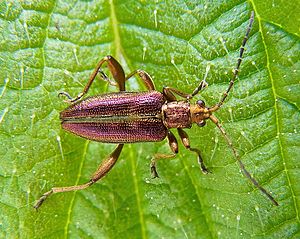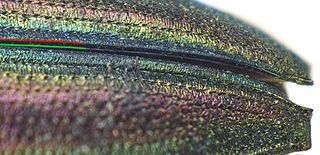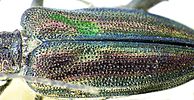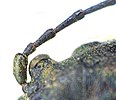Donacia aquatica
| Donacia aquatica | ||||||||||||
|---|---|---|---|---|---|---|---|---|---|---|---|---|

Donacia aquatica |
||||||||||||
| Systematics | ||||||||||||
|
||||||||||||
| Scientific name | ||||||||||||
| Donacia aquatica | ||||||||||||
| ( Linnaeus , 1758) |
Donacia aquatica is a beetle from the family of leaf beetles (Chrysomelidae) and the subfamily of reed beetles (Donaciinae). The genus Donacia is represented in Europe with 33 species .
The scientific generic name Donacia is from Altgr. δόναξ "dónax", "reeds, reeds" derived. The species name aquatica ( lat. "In, living on the water") also refers to the aquatic habitat of the species.
Characteristics of the beetle
Many reed beetles have a shiny metallic sheen, but they are usually solid red or green or blue. Donacia aquatica, on the other hand, shimmers purple to copper red and blue to green at the same time, which is why one of its common English names translates as “rainbow reed beetle”. Depending on the individual and the incidence of light, the blue-green colors predominate and the red tones remain pushed back to a longitudinal stripe in the middle of the wing-coverts (Fig. 3), or the red-violet predominates and limits the green-blue areas to the wing-cover seam and the wing-cover edge (see the picture in the taxobox). Also Donacia vulgaris and Donacia marginata show similar color combination as Donacia aquatica . The two doppelgangers, however, are less colorful than Donacia aquatica , and there are also differences listed below. The violet-red and green-blue coloring of the surface in combination with the flanks and legs that appear golden, the animal can also be identified relatively reliably in the wild.
The head is narrower than the pronotum, the mouthparts point downwards at an angle (Fig. 6). The jaw probes are four-part, the lip probes are three-part. The eleven-link antennae are thread-shaped. They are turned towards each other on the forehead. The third link is relatively long, almost as long as the first (Fig. 4). In Donacia vulgaris and Donacia marginata, however, the third antennae is significantly shorter than the first.
The neck plate (Fig. 5) is viewed from above approximately rectangular front and rear as clear margins. It is wider than the head and narrower than a single wing cover. It is both clearly dotted and wrinkled across.
The wing-coverts , which are very fine and densely wrinkled , have a silky sheen, but are hairless. The wing cover seam is used to reliably differentiate the genus from the similar genus Plateumaris . In Donacia the upper edge of the wing cover seam is not bent up in the rear area, but straight along its entire length (Fig. 2). The space next to the seam is matt shagreen and has a dimple in the front third close to the seam, which often continues as a furrow against the inner shoulder impression (in Fig. 3 above, tinted green). However, this depression is only visible with favorable exposure. The end of the wing coverts is trimmed, the inner corner is pointed (Fig. 2).
The legs are completely black or dark metal, not even partially yellow or red-brown, but appear golden through the hair. They are relatively slim, the hind legs reach the rear edge of the abdomen. The second half of the hind legs has a pointed, thorn-shaped tooth on the underside (Fig. 7). The tarsi are four-limbed, the penultimate limb is clearly lobed.
biology
The species can be found on swampy banks of stagnant and slowly flowing water as well as on moors and moor meadows. Larvae and adults are herbivores. The beetles use only a few host plants as food, in Central Europe mainly the common hedgehog and the common buttercup , as well as the slim sedge .
The adults can be found in Central Europe from April to June. The following information is provided for Northern Ireland: The eggs are laid at the base of the host plants in early summer. The larvae are attached to the roots of aquatic plants underwater. They cover their oxygen demand by drilling into the air supply in the intercellular system of the aquatic plants. The pupae are also bound to air spaces in the root system of the aquatic plants. The development will be completed in late summer. Some newly hatched individuals appear for a short time in September and October before they crawl into the winter quarters. After molting, other individuals remain in the pupa cradle to overwinter for the imago. The next spring, the beetles appear in May and disappear by July. The larvae spin cocoons in the root system.
The adults react to movement in their vicinity and quickly disappear on the other half of the leaf. In the event of a fault, they fly open.
distribution
The Eurasian species is common in almost all of Europe. Within Europe, reports are only missing from Portugal , Bosnia and Herzegovina , Albania , Greece , Macedonia , Bulgaria and European Turkey .
literature
- Edmund Reitter : Fauna Germanica, the beetles of the German Empire, Volume IV, KGLutz 'Verlag, Stuttgart 1912
- Heinz joy, Karl Wilhelm Harde, Gustav Adolf Lohse (ed.): The beetles of Central Europe . tape 9 . Cerambycidae Chrysomelidae . Spektrum Akademischer Verlag, Munich 1999, ISBN 3-8274-0683-8 (first edition: Goecke & Evers, Krefeld 1966).
- Klaus Koch : The Beetles of Central Europe . Ed .: Heinz Freude . tape 3 : ecology . Goecke & Evers, Krefeld 1992, ISBN 3-87263-042-3 .
- Gustav Jäger (Ed.): CG Calwer’s Käferbuch . K. Thienemanns, Stuttgart 1876, 3rd edition
Individual evidence
- ↑ a b Donacia aquatica at Fauna Europaea. Retrieved September 18, 2012
- ↑ Donacia at Fauna Europaea. Retrieved September 18, 2012
- ↑ Sigmund Schenkling: Explanation of the scientific beetle names (genus)
- ↑ Sigmund Schenkling: Explanation of the scientific beetle names (species)
- ↑ Klaus Koch : The beetles of Central Europe . Ed .: Heinz Freude . tape 3 : ecology . Goecke & Evers, Krefeld 1992, ISBN 3-87263-042-3 .
- ↑ a b Northern Ireland Priority Species: Donacia aquatica as PDF






